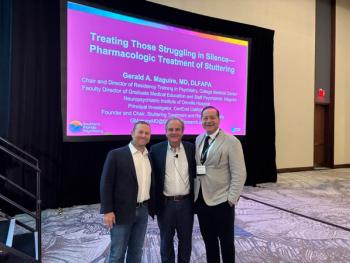
- Psychiatric Times Vol 27 No 11
- Volume 27
- Issue 11
The Business of Pleasure and Pain
The neuroanatomical linkage that emerges from a normal part of business experience-the reaction to success and also to failure (especially if that failure happens to someone else)-is the focus of this column.
The neuroanatomical linkage that emerges from a normal part of business experience-the reaction to success and also to failure (especially if that failure happens to someone else)-is the focus of this column. I am sometimes asked to speak to groups of business executives, mostly to discuss a possible connection between neuroscience and business practices. These meetings are always challenging for me, because I don’t think brain science has much to do with the world of business. My own opinion is that the field of neuroscience is simply not mature enough to tell business executives how to manage their subordinates or how to lure customers into buying their products. “I have nothing real to say to you,” I usually start, “We don’t even understand how humans know how to put their socks on in the morning.”
There are usually some murmurs in the crowd at this point, but since I still have 45 to 60 minutes to burn, I continue, “My perspective isn’t hopeless, though. In fact, almost all of the brain’s neural circuitry can be easily explained-especially if you are looking at people’s interior motivations.” Then I continue with what turns into a Darwinian lecture: “People will do whatever they think will ultimately benefit them. And people will do whatever they can to avoid pain. Almost everything we know about how the brain generates behavior can be couched as combinatorial activations of these 2 broad sets of purpose-driven circuits-seeking pleasure, avoiding pain.”
The human brain as a mass of biological tissue is most clearly understood as a survival organ-the world’s most sophisticated. Given this performance envelope, a great deal of theoretical common ground exists between what we know about the brain and the needs of business. Even though not much of the brain has been mapped, my corporate audiences and I usually end up with lots to say to each other.
This month’s column is all about mapping a specific parcel of this common ground between pleasure and pain and gives a suggestion for a specific investigative direction. We will explore how a subset of these circuits supports the social experience of pleasure and pain.
There is a powerful bridge between pleasure and pain and their social equivalents; indeed, to the brain, they are nearly identical. Recent findings confirm that the same reward circuits are activated during sex and also while delighting in someone else’s misfortune (schadenfreude).1 Similarly, both physical pain and envy over another person’s success activate these circuits.
The biology of pleasure and pain
We start with a basic review of canonical circuits normally associated with pleasure and pain, and then discuss interesting data from a collaboration of scientists in Japan and the United Kingdom. Much of the brain’s pleasure circuitry has been studied through the lens of reward reception and the establishment of addictive behavior. Invariably, this involves the neurotransmitter dopamine and a number of neural circuits that have been isolated and characterized in surprising detail.
Three networks are briefly reviewed. The first circuit involves the interaction of dopamine in neurons within the ventral tegmental area, especially in response to external rewards (eg, sexual activity, drugs, food) (Figure). Associated with these circuits, the second network comprises neurons embedded in the nucleus accumbens, within the ventral striatum. The nucleus accumbens has been shown to play a vital role in the learning of reward and the regulation of pleasurable states. The third circuit involves the ventromedial prefrontal cortex in association with the amygdala. These 3 networks are also vital parts of the dopaminergic system and are thought to mediate reward processing and the emotional responses involved in the ex-perience of pleasure.
Association never means causation. If you could somehow temporarily deactivate the ventral striatum, would schadenfreude suddenly disappear?
The various circuits associated with mediating the experience of pain are collectively termed the “cortical pain network” (
Each region makes unique contributions in the perception of pain. For example, the somatosensory cortex is associated with the localization of the stimulus within the body. The dACC and, to a lesser extent, the insula are associated with the processing of more distressing aspects of pain.
These circuits undergird the twin Darwinian “motivations.” But can I really say that? After all, they have been mostly characterized as physical reactions to rewarding stimuli (such as drugs) or as physical reactions to aversive stimuli (such as an electrical shock). These networks have deep evolutionary roots, which means we share many of these same circuits with other mammals. However, none of this history involves a businessperson’s reaction to marketing strategies or mitigating highbrow office politics that are associated with management.
Does the creation and perception of social rewards and punishments activate the same regions as nucleus accumbens and the dACC? In the past few years, the surprising answer from research is a clear “yes.” Social rewards and punishments appear to hijack the same systems we use to mediate laboratory-based measurements of pleasure and pain. If you are being treated fairly, are feeling cooperative, or have been blessed with a good reputation, you feel so in part because of circuits activating the ventral striatum. This reward network is activated whenever you make a charitable contribution-even more than if you suddenly inherited a lot of money!
Similarly, specific circuits of the cortical pain network become activated whenever you experience social pain, such as grief over the loss of a loved one. The same circuits are activated if you feel you are being treated unfairly. The dACC and insula are recruited whenever you feel socially excluded. The more social pain you feel, the more activity is generated within the dACC.
The bottom line is that the brain appears to treat material physical stimuli and amorphous social perceptions in a manner more similar than previously thought.
The data
Researchers from Japan and the United Kingdom explored 2 specific types of social interactions in a 2-part study1 involving the above data. What they found has potentially high relevance to business practices. While it is beyond the scope of this column to go into specifics, we will say that in general, 19 volunteer participants were supplied with information concerning imaginary target persons. These persons were characterized by levels of possession and self-relevance. The participants underwent functional MRI, more social information was supplied, and the experiments commenced.
When the participants were told that the targets had superior possessions and self-relevance, they reported strong feelings of envy. Surprisingly, the areas of the brain associated with physical pain-particularly the dACC-showed a very strong signal in the people experiencing envy, even though no physical pain was being experienced. The effect appeared to be linear and cumulative. The more envy evinced, the stronger the dACC signal was observed.
For the second part of the study, researchers tested for schadenfreude, or delight in someone else’s misfortune. The participants were told that the “superior” targets had experienced something awful. What did their brains do? The areas associated with pleasure, particularly the ventral striatum, showed an immediate and powerful activation. This effect was also linear and cumulative. The more envy evoked in the first part of study, the greater the pleasure signals were observed in the second. For the first time, research demonstrated a lively and dramatic integration between the experiences of social pleasure and social pain.
Conclusions
There is a lot more work to be done before a clear picture emerges. For one thing, areas of the brain-such as the dACC and the ventral striatum-include a broad range of activities, not all of which fall under the rubric of pleasure and pain mitigation. Experiments will need to rely on the power of future technologies to identify the boundaries of actual neural networks involved. And, of course, association never means causation. If you could somehow temporarily deactivate the ventral striatum, would schadenfreude suddenly disappear? This research has yet to be done.
Still, the data in context with previous research undergird critical insight into the incredible evolutionary importance of social relationships to the human brain. Many researchers believe it was our dependence on relational activities that created the need for this big, unique brain of ours in the first place. As weak as our bodies are, it was more convenient for us to double our biomass by creating a cooperative ally than by creating a bigger body. This meant putting pressure on a relatively small number of neurons in the brain, rather than a large number of cells throughout the body.
Moreover, the brain is an efficient and evolutionary manager of its bioenergetic needs. It is not surprising that regions associated with the physical needs of pleasure and pain might be recruited for the more abstract social versions of the same thing. The gift this gives people interested in the biological roots of behavior is enormous: certain previously considered subjective expe-riences-such as envy-may not be as subjective as we once thought. If that’s the case, I will eventually owe my business audiences a big apology. Perhaps in a few years, brain scientists will have something to say to business people interested in improving their “bottom lines.”
References:
Reference
1. Takahashi H, Kato M, Matsuura, et al. When your gain is my pain and your pain is my gain: neural correlates of envy and schadenfreude.Science.2009;323:937-939.
Articles in this issue
about 15 years ago
Domestic Violence: Three Important Truthsabout 15 years ago
Comprehensive Dictionary of Psychoanalysisabout 15 years ago
The “Minimum Necessary”: How Much Will You Need to Divulge to Insurers?about 15 years ago
Early Signs of Autism Spectrum Disordersabout 15 years ago
Looking Backabout 15 years ago
Vincereabout 15 years ago
Clinical Manual of Sexual Disordersabout 15 years ago
Forensic Ethics, Interrogations, and Getting the Facts Rightabout 15 years ago
The Forensic Psychiatrist and the Code of Medical Ethicsabout 15 years ago
Adding the Diagnosis of Temper Dysregulation Disorder to DSM-5Newsletter
Receive trusted psychiatric news, expert analysis, and clinical insights — subscribe today to support your practice and your patients.














